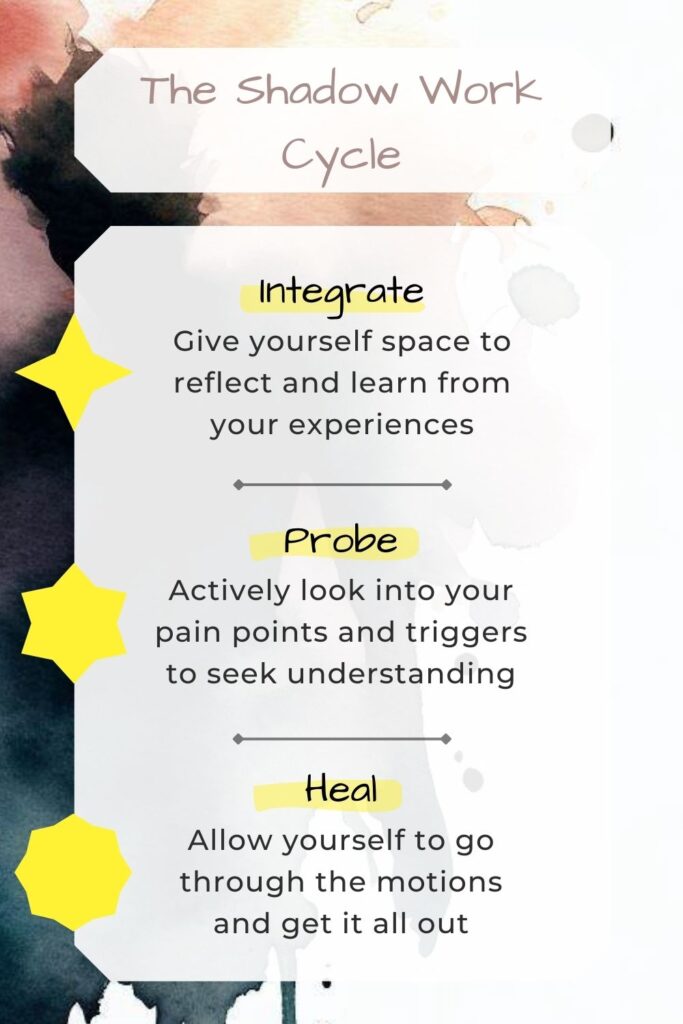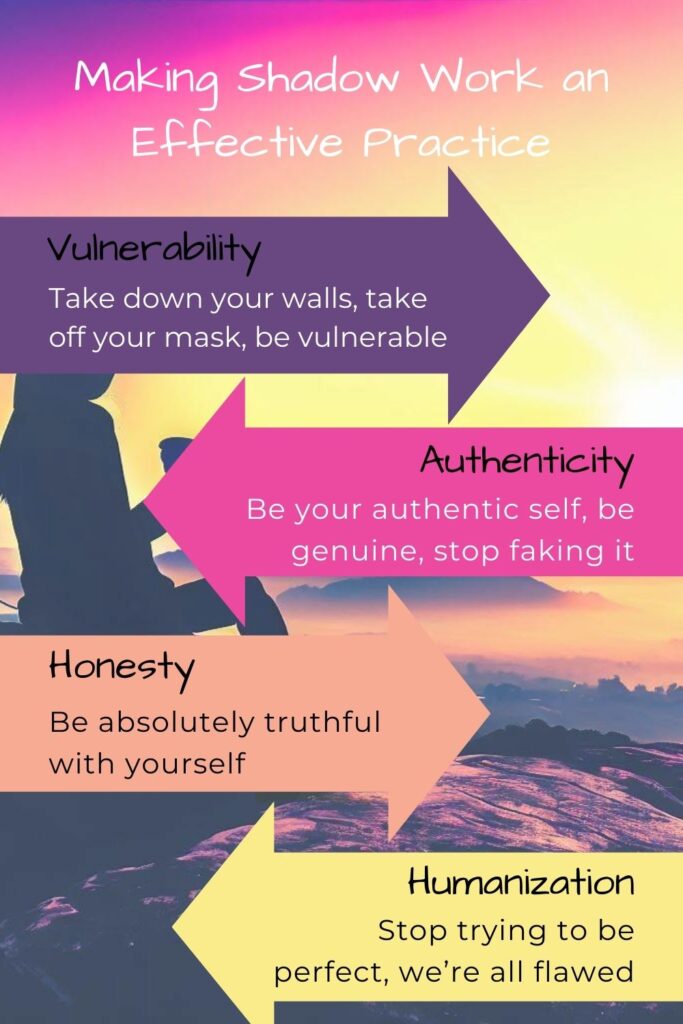How important is it to look like you’re doing well in life? You want to be seen as a winner in life because you’re the hero of your own story, it’s only natural. But are you suppressing everything less than photogenic due to your insecurities?
Are you hiding aspects of your identity from the world because you don’t want to be associated with them? You might fool the world, you might even fool yourself, but beyond this facade is a wounded, less-than-perfect you, and maybe, you just need to give him a little support.
We all have a shadow that lives undisrupted in the unconscious mind. This shadow represents the ugly side of who you are and shows its face when you drop the mask. You try to maintain an image that you’re successful, and mature, or that you have your life together to avoid looking at this shadow.
However, that shadow can’t simply be ignored because it’s a part of you.
Until you bring awareness to this shadow, it will always be there within you, showing its face in the form of dysfunction. It can be an uncomfortable process looking at your demons, but it’s also a liberating process. A process that’s necessary if you want to experience wholeness: Where you’re not constantly on the run from yourself.
Shadow work is the process of integrating the hidden aspects of yourself that aren’t so beautiful to look at. So let’s explore this practice so you know how to bring your dark side to the light, to become a more integrated person.
What is shadow work?

Shadow work is the process of integrating aspects of yourself that you have rejected. It’s an essential part of the healing process, and a necessary practice if you feel like you’re missing something in your life.
In other words, shadow work is the act of bringing light to hidden trauma, and integrating aspects of yourself that you once disowned.
Illuminating the darker, hidden aspects of yourself allows you to heal the wounds that have caused your shadows. If you’re not aware of them, how are you supposed to work on them?
Imagine the practice of shadow work as peeling off the mask you’ve been wearing your whole life – and scrubbing off the grime that has built up underneath it. These undesirable aspects of yourself have been rotting away underneath the pretty facade you’ve been wearing, as they haven’t seen the light of day.
Avoiding shadow work leads to issues such as disintegration and spiritual bypassing, which is to act as your higher self, but not be integral to it.
But you need to bring awareness to your ugly side and accept it as a part of who you are. This is where you can start healing it, and integrating it into yourself.
The benefits of shadow work
There are a lot of benefits to shadow work, and it’s a deeply rewarding process. Shadow work acts as a powerful platform for healing and integration, as real healing requires you to look at the ugly side of yourself. By confronting your inner demons, you gain a deeper understanding of:
- Why you are the way you are, and what caused you to be this way
- Your wounds. You more clearly see your trauma, what caused it, and how it is affecting your life
- Your dysfunctional self-image, and why you see yourself in certain ways
- You can identify limiting belief systems and begin to work on them.
If you don’t integrate your shadows, you create a divide between the higher self and the lower self, instead of recognizing that it is all the self.
This can have some serious consequences on your well-being.
Have you ever been triggered and exploded? You might be a gentle, kind person, but at times, something might overtake you. That’s because a repressed side of yourself is coming out, and instead of just having a normal reaction that is integral to who you are, the repressed side comes out in force.
By putting on a mask and covering up the wounds that cause you to feel a certain way in the first place, you never actually heal. This means there will always be some sort of dysfunction in your life. You might not notice it, but it will be there, and it will manifest in different ways until you get to the root issue.
Shadow work can also help you develop greater self-compassion. After all, it’s a journey of self-love that can lead to greater fulfillment and authenticity in your life.
What is shadow work helpful for?
- letting go of painful memories and the associated emotions
- Healing childhood trauma and deep-rooted wounds
- Overcoming particular blocks in your life (relationships, money etc.)
- Recognizing and correcting dysfunctional attitudes, behaviors and beliefs
- Identifying harmful mindsets and perceptions
- Discarding self-sabotaging belief systems
- Spiritual growth and a better understanding of who you really are
- Becoming more comfortable with yourself
- Discovering passions and interests that have long been repressed
- Gaining more clarity about your life situation
When is shadow work necessary?
- When you experience something undesirable about yourself, whether it’s a thought, feeling or belief, it needs to be processed and understood
- You find yourself frequently experiencing emotions like anger, jealousy, or shame, and you’re not sure why
- You have an unexplained aversion or dislike to something (like meeting someone and instantly disliking them, but you’re not sure why)
- You notice self-sabotaging behaviors such as avoidance of positive things, procrastination, addictions, or indecisiveness
- When you notice a recurring pattern of issues in your relationships that seem to follow you
- You’re always on edge but can’t pinpoint why
- Past memories or traumas are repeatedly resurfacing, and you have an unconscious habit of pushing them away
- There are some deeper insecurities that you know you need to address
- When you get triggered by something, or see an ugly side of you come out that was unwarranted
Understanding the shadow-self

The shadow self is an analogy of your lower self and represents everything that’s wrong with you. In this sense, the shadow self is a reflection of everything that’s negative, painful, or undesirable about yourself. It’s the side of you that you’re trying to avoid.
Characteristics, behaviors, and attitudes that you perceive as inferior are disowned and consciously avoided (which creates the shadow self).
Anything that you see as contradictory to your beliefs about who you should be is repressed. This creates polarity within your sense of self.
As people tend to focus on being their best selves, they often end up completely abandoning anything that doesn’t resonate with their image of who they want to be. This is called spiritual bypassing – and it’s not a good thing.
True healing takes time. There’s no quick fix or way around it. When people try to become their best selves but refuse to do the dirty work, they end up pushing aspects of themselves into their shadow. What happens is the surface looks all nice and shiny, the person might be polite, charismatic, confident, and secure – but it’s just a play. Their persona is not integral to the way they feel.
This shadow eventually starts leaking out in the form of breakdowns, behavioral issues, and emotional issues – and manifests into all sorts of dysfunction in your life. How often have you gotten to know someone who seemed great, then bit by bit, you see more dysfunctions surfacing?
When your shadow is not integrated, you will have a feeling that something isn’t quite right, and wonder why you still have so many issues. But usually, you will have no idea what the cause is, because the surface looks clean. You can’t just pretend a part of you doesn’t exist. And if you do, then perhaps you won’t have to look at it, but it’s never actually going away.
When you’re fully healed, you don’t have a shadow self. You just have a self, which experiences all things pleasant and unpleasant, ‘good’ and ‘bad’, without labels or judgment. You’re not trying to escape a part of you, as you’re comfortable in your skin, and have an authentic expression.
How is the shadow self created?
Imagine you’re a kid, and a family member scolds you for expressing anger. Even though the intention might not be bad – you start believing that these emotions, or experiences are bad.
As a result, you learn to repress those emotions, and consciously avoid them every time they come up. So you start walking on eggshells and swallow it every time you feel upset. You begin to believe that this side of yourself shouldn’t be expressed, the more you repress it.
It’s not like you’re working on the root cause of these painful emotions that are causing your anger in the first place, or finding a healthy vent for them, you’re just shoving it out of awareness and covering it with a façade.
Since this aspect of yourself is repressed, this means you can’t work on it. Therefore, it continues doing damage under the surface until you bring this repressed part of yourself into awareness, and integrate it.
Another example is if you were bullied, or perhaps made fun of for crying in school. Due to the shame you experienced, you create the belief that crying is unacceptable, or unmanly. So you grow up repressing normal human emotions like sadness every time you feel it.
So what happens? It begins forming dysfunction, something you can’t quite put your finger on – because you haven’t associated the cause and effect. You might start having issues with mental health later down the track. You may start getting triggered by people, or having seemingly random emotional outbursts when someone rubs you the wrong way.
You may begin unconsciously avoiding any situation that could potentially bring up these sorts of emotions – which results in limitations in your life. There will be another unpleasant side of you that will keep showing its face because this shadow has never been understood and healed.
Discover your shadow self
By looking into your shadow, you can discover a lot about yourself. Are you insecure, but cover it up with a confident persona? Do you find yourself seething with anger sometimes, but manage to keep it under control? Are there aspects of your personality that you try to hide from people because you’re ashamed of them?
If you’re aware of this, then you’ve already made a great start. From here, you can pretend to be the highest version of yourself and neglect anything that doesn’t resonate with you. This might work for some time, but it’s going to cause more problems down the track.
Or you can look at the wounded, dysfunctional part of your psyche – and take action to heal those neglected parts of yourself. This is the path of genuine healing and transformation, not the quick Band-Aid fix.
Think about what the worst possible version of yourself would look like. You’re trying to build a picture of yourself if you went in a really bad direction, and became everything that you despise. This is your alter ego, the worst version of yourself, a portrait of your lower self.
Do you see yourself as a drug-addicted loser, an insecure beta male who just never gets it, a freak that nobody likes, or a colossal failure to your parents, wife, or loved ones? Does it sting to see yourself in this light? Good, it should.
Build an accurate image of what the lowest version of yourself looks like. The more it hurts thinking about this version of yourself, the more shame or guilt you feel, the better. So use your emotions as a compass, because it means you’re hitting on a sore point.
- What do you look like?
- What is your personality like?
- What does your lifestyle look like?
- What sort of things do you do?
- How are you with other people?
- What is it about yourself that you just can’t stand?
Healing the discarded aspects of self

Shadow work isn’t something you do. It’s the process of sitting with your emotions, reflecting on the negative things you’re feeling, and eroding your past trauma.
To integrate your shadow self, you first need to cultivate an awareness of what you’ve repressed and explore it. This can be a particularly uncomfortable process, but it’s necessary. Use your shadow avatar that you just created to dig into what you’re feeling, and why you’re feeling it.
After being aware of what aspects of self have been repressed, you need to accept those parts of yourself and show yourself compassion, love, and understanding. The healing is a byproduct of being aware of your pain points, looking into them, and sitting with the emotions until they no longer sting.
In the same sense, you’re always doing shadow work, as long as you’re conscious about it every time something painful comes up. On the other hand, if you decide to put on a façade that you’re perfectly fine, you’re not going to explore your shadows and the same patterns are going to reoccur in your life.
If you’re pissed off because you got screwed over by a client, shadow work is sitting with those emotions, inspecting why you feel so frustrated, and organically letting go of the resentment you’re feeling.
So when you are feeling something painful, it’s good to minimize distractions and avoid escaping those feelings. This is why it’s good to give yourself an audience by meditating, journaling, or simply just by sitting with your thoughts and going through the motions in silence.
Integrate the experience
When something comes up, you need to reflect on it. Every painful emotion that surfaces, spend some time introspecting, feeling it, and integrating the experience of why it’s there, and what you can learn from it.
Probe your pain points
Probing is to seek understanding about why you are the way you are. This is done by poking around on your wounds to see what comes up, and what needs to be worked on. Probing is the inquisitive, learning part where you bring repressed aspects of yourself to the surface, and provoke an emotional reaction.
Heal the open wounds
Healing is the act of expunging energies from your body. It’s an essential part of the shadow work process and creates space for integration. This is the charged, painful part of the healing process. It’s when you feel a build-up of painful energy, and get it all out.
Allow yourself to be vulnerable
If your walls are up, you’re just preventing yourself from doing the hard work. Let yourself be vulnerable and allow your inner (wounded) child to come out, so that the real work can be done.
Be authentic
Being authentic is to be true to what you feel, instead of beating around the bush. If you feel like crying, cry. If you feel painful emotions come up, acknowledge them. You need to make a practice of being in tune with your emotional body, and processing everything uncomfortable that comes up.
Be honest with yourself
Be honest about who you are and what you need to work on. This includes being sincere about your traumas, what hurt you, and the things you’re feeling. If you’re just pretending that all is fine and dandy, you’re not going to get anywhere in the shadow work process.
Humanize the experience
Be real with yourself. Don’t think you’re a robot that always has it all under control. Recognize that you’re not perfect, that it’s hard, and this humanization will make it much easier on yourself.
Best shadow work practices
Now that we’ve looked at some techniques and processes to integrate your shadow self, now we’re going to look at practices you can do to aid this process. Start doing these practices when needed, and every time you see your shadows surface, you can further integrate them into who you are.
The more you make a habit of integrating your shadow self every time it comes up, the less of an appearance it will make. What this means is that you won’t have the same triggers and setbacks anymore. After a while, you’ll realize that you feel good.
You’re not ashamed of yourself anymore. You can express yourself in a healthy way. What you were trying to get away from is gone, and it’s not an issue anymore, which opens up a much healthier expression of self. Bit by bit, build the habit of sitting down with these unpleasant feelings, exploring them, and processing them.
Watch your triggers
Your shadow often comes out through triggers. Triggers are essentially a leakage of your unconscious mind, and occur when someone presses on a sore point that has been covered up. Triggers can take the form of lashing out, having an emotional outburst, or having some sort of reaction that isn’t proportional to the cause.
By being aware when you’re having these reactions, you can start to uncover why you’re having such a big reaction to something that most people see as such a little deal. This will point you in the direction of your discomfort, where you can feel those emotions, sit when them, and heal them.
Engage in inner dialog
Do you ever just talk to yourself and create a dialog? It’s a good way to really animate a thought process, and flush it all out. If you’re feeling a certain way, or something has come up that you don’t like, I suggest talking about it with yourself. Allow yourself to vent and get it off your chest. Seriously… give it a try. I go into more depth about this in the article below.
Make a habit of writing in a journal
Personally, I keep a shadow journal which is a collection of all my dark and painful thoughts, feelings, beliefs, and so forth. By keeping a journal and recording your healing process, you are bound to catch a lot of things that come up, and more easily find patterns and triggers.
Writing down all your negative thoughts and feelings when you’re experiencing them will give you more clarity, organization, and help when doing the dirty work.
Express yourself through an artistic medium
Do something creative that channels your subconscious mind. It doesn’t really matter what you do, as long as the medium allows you to get into that flow state. By getting into that flow state, you express a part of yourself that doesn’t get expressed much.
By doing this, you bypass the conscious mind, and this is great for inspecting what comes out. Likewise, it acts as a purge, as you’re releasing pent energy and expressing yourself through a particular medium which is healing in itself.
Practice a meditative discipline
Things like meditation, attending healing ceremonies, and yoga are great ways to encourage your shadow to come to the surface. Usually, we distract ourselves and try to avoid looking at the shadow self, so by making a practice of looking deep into yourself, it’s going to be easier to see your shadow and work on it.
New to meditation and not sure where to start? I wrote a complete guide for meditation which you can find by following the link below.
Use shadow work prompts
Shadow work prompts are questions, keywords, or phrases intended to trigger certain thought processes and facilitate introspection. By reading through prompts and seeing if any painful emotions surface, you can make a habit of sitting with those emotions, processing the experience, and letting the trauma go.
Prompts can really be anything, and they’re a great way to probe around and find out if you have hidden wounds that need healing. I write an article dedicated to shadow work prompts which you can find below. So if you’re looking to dive deeper into your healing right now, follow the link below.




2 comments
I have this question, What to do after shadow work, you find an area or a trigger but the behavior that was suppressed is still there, nothing has changed in the environment. I have an example, I do not like noisy people, my shadow is that I am introvert, never liked to be outspoken and it has got to me. I started feeling really annoyed with extroverts and now I know why. I would have liked to be more extrovert, I am not. So, I got surrender by extroverts, because there is nothing an extrovert likes more than a quite person, right? It seems that everybody that surrounds me is an extrovert! I had it with it. I know it was my introvert wanting to talk, participate, resenting the lack of opportunity because the noisy extrovert. What should I do know, scream louder? change friends? :)
Thanks for your question, and good work on the progress you’re making. As you’ve discovered why you don’t like extroverts, that’s a good starting point, as awareness allows you to do the work and break the cycle.
Part of really understanding your triggers is to spend time sitting with those unpleasant feelings when they surface. It’s important not to see it as a 1 time thing. These triggers will continue showing up as a way to indicate that there’s something that needs healing inside you. But every time you sit with the feelings of being triggers by being aware that it’s just a trigger, meditating on it, and feeling it fully, those feelings are going to lose a little bit of power every time you do that.
Mostly, you just want to be consistent. Triggers often get louder as you really start digging into them. That’s your ego’s way of trying to scare you off so that you don’t poke around a wound. So just be present with those feelings, and if you keep doing that every time they come up, you’ll intuitively receive more insights, and eventually you’ll notice that you don’t have that trigger anymore.
Hope that makes sense!